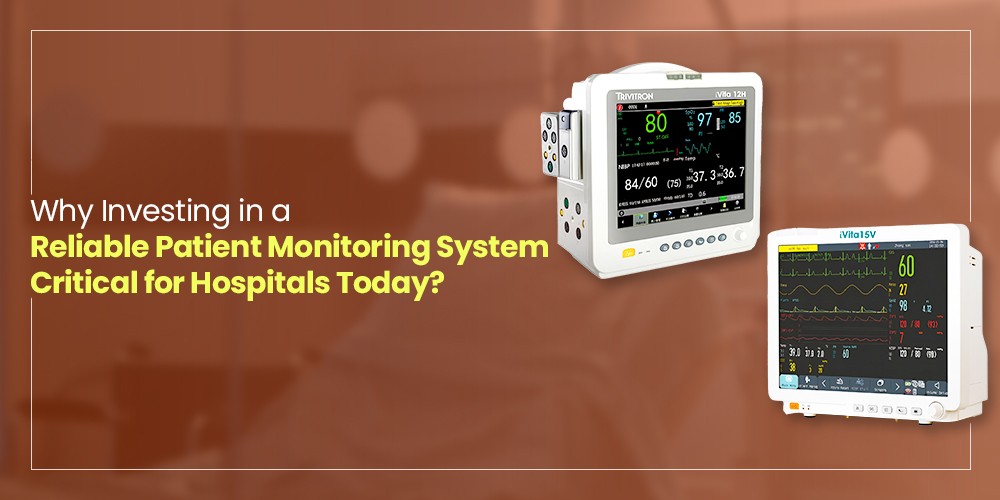In a hospital setting, every second counts. A patient’s condition can change unexpectedly, and without timely intervention, the consequences can be severe. A high-quality patient monitoring system ensures that even the smallest fluctuations in vital signs are detected in real time, allowing medical professionals to respond swiftly. By providing continuous and accurate tracking, these systems enhance patient safety, reduce human error, and ultimately save lives.
A high-quality patient monitoring system (PMS) is the cornerstone of modern healthcare, enabling real-time tracking of vital signs to ensure timely and effective medical intervention. By continuously monitoring patients, these systems not only enhance safety but also streamline hospital operations, reduce human errors, and improve overall health outcomes.
Let’s explore why hospitals should invest in a state-of-the-art patient monitoring system and how it enhances patient care, improves hospital performance, and supports financial sustainability.
1. Improving Patient Safety & Outcomes
A reliable patient monitoring system provides real-time, high-quality data that helps detect early signs of patient deterioration through continuous vital sign tracking. This second-by-second monitoring allows healthcare professionals to respond immediately at the first sign of an emergency, ultimately reducing the risk of complications and mortality.
Advanced monitoring systems significantly reduce the risk of human error compared to manual methods. Automated data collection minimizes the chances of misreadings and ensures critical information is accurately recorded. This is especially vital in high-dependency areas such as ICUs, neonatal care, and post-operative recovery, where even a few seconds can make a life-saving difference.
Modern patient monitoring technology also supports remote access, enabling physicians to track a patient’s condition from outside the hospital even while the patient is at home. This is particularly beneficial for post-surgical care, chronic disease management, and home-based healthcare, allowing for timely interventions and helping prevent hospital readmissions.
2. Enhancing Hospital Efficiency and Workflow
A centralized patient monitoring system eases the workload on nursing staff by automating routine checks and sending alerts only when clinical intervention is necessary. This allows nurses to focus on higher-priority tasks, improving productivity and reducing burnout.
When seamlessly integrated with Electronic Health Records (EHRs), patient monitoring systems eliminate the need for manual charting by instantly sharing real-time data with healthcare providers. This reduces documentation errors, enhances decision-making, and promotes better care coordination across departments.
Advanced systems also include Early Warning Scores (EWS), which use changes in patient parameters to predict potential deterioration. These predictive insights allow clinicians to intervene proactively helping prevent critical events such as cardiac arrest, sepsis, or respiratory failure before they escalate.
3. Cost Savings and Financial Benefits
Patient monitoring systems support the early detection of health issues, which helps reduce unnecessary emergency room visits and enables quicker interventions. This often leads to shorter hospital stays, benefiting both the patient and the hospital by lowering overall treatment costs and improving patient satisfaction.
Accurate, continuous monitoring also minimizes the risk of medical errors, thereby reducing the likelihood of costly malpractice claims. By maintaining a reliable record of patient data, hospitals can protect themselves legally and uphold their reputation for safe, high-quality care.
Additionally, a well-implemented PMS helps optimize the use of hospital resources. With accurate data, critical care units can be managed more efficiently, avoiding overcrowding. Improved insights into patient needs also support better staffing decisions and more effective use of medical equipment, ultimately reducing operational expenses.
4. Meeting Compliance and Regulatory Standards
Hospitals are required to manage patient data accurately and securely to comply with healthcare regulations. A reliable patient monitoring system helps ensure adherence to key standards such as HIPAA, FDA guidelines, and Joint Commission requirements, minimizing the risk of non-compliance and associated penalties.
Regular quality audits are conducted to assess whether hospitals meet established standards for patient care. Automated monitoring systems simplify this process by generating real-time and historical data reports that support audit readiness.
By leveraging these automated reports, hospitals can streamline compliance efforts, reduce administrative burden, and maintain accreditation with greater ease and confidence.
Understanding Patient Monitoring System Pricing
Factors Affecting Price
The cost of a patient monitoring system depends on several variables, including system features, brand reputation, and integration complexity. Advanced functionalities such as real-time data analytics, wireless capabilities, remote access, and AI integration can influence pricing significantly.
Investment vs. Long-Term Savings
While high-end monitoring systems may require substantial upfront investment, they offer considerable long-term savings. These systems reduce the likelihood of costly medical errors, minimize readmissions, and decrease the need for extensive manual intervention. Hospitals that invest in quality monitoring solutions often benefit from better clinical outcomes and greater financial sustainability.
Choosing the Right System for Your Hospital
Selecting the right patient monitoring system requires a balance of features, cost, and reliability. Hospitals should assess the system’s integration capabilities, vendor track record, and post-sale support to ensure a sound investment.
In Conclusion
Investing in a high-quality patient monitoring system is no longer optional; it’s essential. These systems enhance patient safety, streamline hospital operations, and reduce healthcare costs. Hospitals equipped with advanced monitoring technologies are well-positioned to lead in a rapidly evolving healthcare landscape, delivering better care and staying ahead of future challenges.

